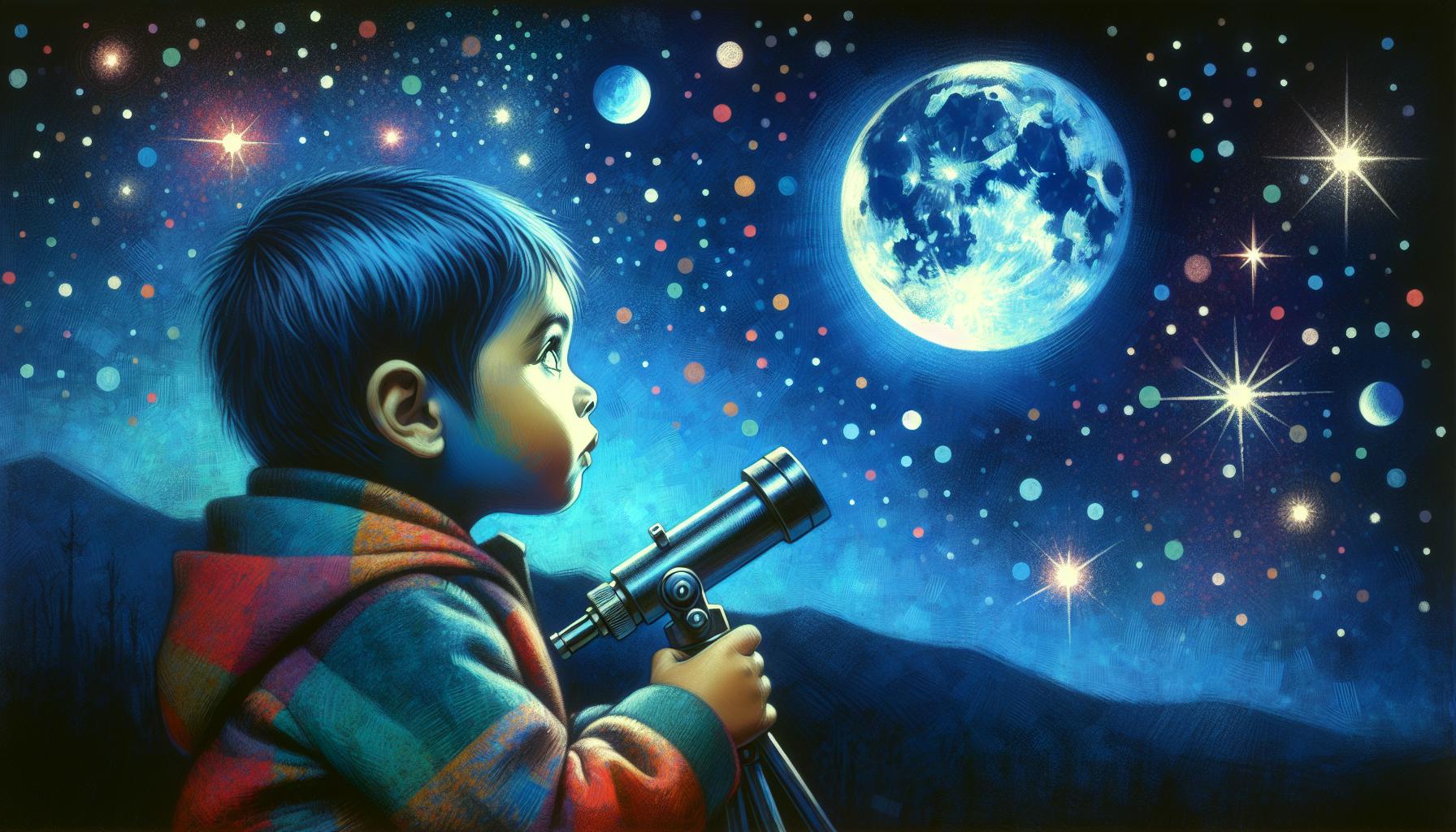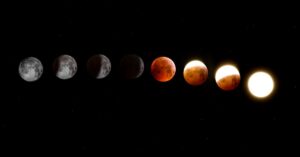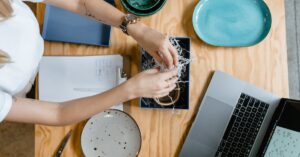This site contains affiliate links to products. I may receive a commission for purchases made through these links.
If you’ve got a curious toddler at home, there’s nothing quite like a DIY telescope to spark their interest in the stars. It’s a fun project that’s not only educational but also helps to foster a love for astronomy early on.
Materials Needed
Alright, let’s dive into the nitty-gritty part of our DIY telescope project. A wonderful aspect of this task is that most of the materials are likely already at your home. If not, they are quite easy to find at any local store or online. So, what are we going to need?
- Two empty paper towel rolls. The main body of the telescope will be created from these.
- Scissors, glue, and tape. These will help in the construction phase of our DIY telescope.
- Aluminum foil. This enhances light reflection inside our homemade telescope.
- Construction paper and colored markers. These materials will allow your little ones to personalize their telescope and make it their own.
A handy aspect of this project is that it’s possible to substitute materials. For instance, if paper towel rolls are not available, you can use toilet paper rolls or wrapping paper tubes.
For our largely toddler audience, let’s break down the quantities needed of each material. We won’t be needing a whole bunch of anything, really.
| Materials | Quantity |
|---|---|
| Empty paper towel rolls | 2 |
| Scissors | 1 |
| Glue | to preference |
| Tape | to preference |
| Aluminum Foil | 2 sheets |
| Construction Paper | to preference |
| Colored Markers | to preference |
As you gather these materials, get your toddler involved too. This way, they become a part of the process and start to feel ownership of their DIY telescope. Plus, it’s a great way to help them understand the procedure.
Collecting and preparing the materials for this project can also be an educational moment in itself. This may be a good time to explain to the little ones about recycling and how essential items can be reused for creative means. It’ll act an early lesson on responsibility towards our environment.
Once we’ve got all these materials, we’re all set and ready to move to the next phase – building the telescope. But we’ll get to that in the next section. Don’t worry it won’t be complex, it’s all about fun and learning.
Step 1: Gather the Supplies
Alright, we’ve gotten our list of materials for our DIY toddler telescope, now it’s time to gather them all up. Embrace this phase as the first fun activity you can do with your toddler. Rolling up your sleeves to embark on a scavenger hunt around the house sparks curiosity and fuels the anticipation of the project. There’s something about preparing and gathering supplies together that always amplifies the excitement, isn’t there?
The list of items we need for our DIY telescope isn’t too extensive. Involving your toddler in this step not only makes them feel like an integral part of the process, but also serves to educate them about recycling and the value of reusing items that are readily available at home.
Here’s the list of materials you’ll need:
- Two empty paper towel rolls
- Scissors
- Glue
- Tape
- Aluminum foil
- Construction paper
- Colored markers
Make sure to run through this list thoroughly to ensure you’ve got everything in place. Remember, safety first. While gathering supplies, pay extra attention to items like scissors that could potentially pose a risk to your toddler. Opt for kid-friendly alternatives wherever possible.
Step 2: Assemble the Telescope Body
With all the necessary materials now in hand, let’s move on to the exciting part – assembling the telescope body! Just follow these simple, easy-to-understand instructions and you’ll have your toddler’s very own DIY telescope ready in no time.
First, grab both your paper towel rolls. Decide which one you’ll use as the main body of the telescope and which will serve as the extendable part. Now, take the main body roll and partially wrap it in aluminum foil. Remember, the foil serves as a reflector to enhance the ‘telescope look’.
Next, safety first! Break out those kid-friendly safety scissors and trim roughly an inch off the second tube. That’s going to help it fit snugly inside the main body and truly give your telescope a professional feel.
Now that both paper towel tubes are prepared, it’s time to attach them. Slide the smaller tube inside the larger one. Secure it in place with some tape – not too tight! You want to be able to rotate the smaller tube inside the larger one to simulate the zoom effect of an actual telescope.
No DIY project is complete without a dash of imagination and fun. Bring out construction paper and colored markers, and let you and your child’s creativity take the wheel. Wrap the telescope body in construction paper of your toddler’s choice and begin decorating.
Let them flex their artistic muscles with doodles, stickers, or an awesome starry night sky. The important part is to have fun, bond, and create something your child will take pride in.
Step 3: Attach the Lenses
In the next phase of our DIY toddler telescope creation, we’ll be attaching the lenses to our constructed body. This step is crucial as it’s the one making our simple craft truly resemble a telescope.
Grab the two plastic lenses—magnifying lenses that we selected based on their safety for toddler use. Clear, break-resistant material is imperative here. It’s also important to bear in mind the size of the lenses. We’re working with two different sizes. The larger one should fit the main body tube’s circumference, and the smaller one should comfortably fit within the second, inner tube.
Let’s start with the larger lens. Affix it to one end of the main body tube with the help of tape or a hot glue gun. This lens serves as the eyepiece. Safety note: if you’re using a hot glue gun, make sure to do it yourself and keep it out of children’s reach.
Here’s how our work should look at this point:
- Main body tube snugly wrapped in aluminum foil
- Larger lens attached to one end of the body tube
- Second tube already trimmed and set aside
We move to the smaller lens. This one needs to be placed at one end of the trimmed second tube. Secure it in similar fashion, using tape or hot glue. The end of the tube sporting the lens gets slid into the other (non-lens) end of our main body tube. Voilà, we have a telescope!
Your child’s excitement over this creation will likely sky-rocket now that we’re seeing a real telescope taking shape. They’ll be eager to customize it. Feel free to move on to decorating the scope, even as we continue with minor, but important, adjustments in the next steps.
Just remember, safety first, fun next—always. Keep a watchful eye on the little ones while engaging in this creative project. It’s a balance of doing tasks ourselves while involving our toddlers in non-risky, imaginative parts of the process.
Step 4: Decorate Your Telescope
Now that we’ve assembled our toddler-friendly telescope, it’s time to add a layer of creativity. This step brings a personal and fun aspect to our DIY project. It’s all about expressing individuality and fostering your kid’s artistic flair.
Decorating can be as simple or elaborate as you wish. Feel free to break out the paint and paintbrushes, or utilize colored construction paper. Remember, safe and non-toxic materials are a must.
You’ll want to start by covering the main body tube. If you’re using paint, ensure it’s thoroughly dried before proceeding to the next step. If you opt for construction paper, cut it to the correct size and use a non-toxic glue to adhere it to the tube. You could even use safety scissors and let your toddler be part of this fun activity.
Once the main body tube is attended to, don’t forget about the smaller trimmed tube. Differentiating the two tubes with distinct colors or patterns could make the telescope even more visually appealing.
Adding embellishments takes your homemade telescope from plain to fantastic. Think stickers, glitter glue, or even fun foam shapes. The sky is literally the limit here. Just be certain that any embellishments won’t obstruct the lenses.
Throughout this process, always prioritize safety. Small items pose potential choking hazards, so supervise your toddler to ensure they’re safe.
It’s worth noting that decorating is more than just a fun artistic endeavor. It also instills a sense of ownership and pride in the craft and can increase your child’s interest in using the telescope.
Step 5: Explore the Stars
Now that we’ve let our creativity fly in the decorating process, it’s finally time to take our toddler-friendly telescope and journey into the fantastic world of astronomy. Toddlers have an innate curiosity for the world around them and there is no better way to foster this curiosity than by exploring the stars together.
Our first tip? Just let your child indulge in the mystery and beauty of the night sky. Point out to simple constellations and the moon, they are easier to spot and let them marvel at their beauty. You’ll see an instant spark in their eyes; it’s a sight you’ll cherish for a lifetime.
It’s essential to keep the sky gazing sessions short and engaging. Remember, we’re dealing with toddlers; their attention spans are notoriously thin. The key here is to keep their curiosity piqued without making it feel tiresome.
If you’re not well-versed with constellations, don’t let that deter you! There are plenty of educational children’s books on this subject that you could refer to. As a bonus, they are often beautifully illustrated, capable of captivating little eyes and making learning a fun process. After all, isn’t that what we’re aiming for?
For nights when the clouds cover the sky or the weather doesn’t permit outdoor activities, I’ve found that planetarium apps come in very handy. They are interactive and utilize the magic of technology to bring the night sky to your living room. Inputting your location will provide a real-time view of the stars and planets visible from where you are. Most of these have a toddler-friendly interface, making it easy for them to navigate and explore the stars.
As you journey into the world of astronomy together, you’ll notice a growing eagerness in your child to know and learn more. This is how the best learning happens – led by a child’s curiosity and fueled by the joy of discovery.
Remember, we’re not aiming for perfection here; our goal is to instill a love for learning and exploration in our toddlers. The telescope we’ve created is a tool, a gateway into a world full of wonders that is just waiting to be explored. So let’s embrace this journey with enthusiasm and, most importantly, enjoy the process.
Conclusion
So there you have it. I’ve shown you how to spark your toddler’s interest in the stars above with a homemade telescope. Remember to keep stargazing sessions short and fun. Use resources like children’s books and apps to supplement real sky gazing.
This isn’t just about astronomy. It’s about nurturing your child’s innate curiosity and love for learning. Who knows? You might be raising the next Galileo or Hubble. So go ahead, step outside and start exploring the night sky with your little one. It’s a journey of discovery that’s sure to be as exciting for you as it is for them.
Frequently Asked Questions
How can I keep my child engaged during sky-gazing sessions?
To keep sessions engaging and accessible, it’s recommended to keep them short, focus on basic constellations, and fortify the experience using educational children’s books and planetarium apps.
Is the toddler telescope useful on all nights?
While the telescope is an excellent tool for stargazing, there can be nights when outdoor activities may not be possible due to various reasons. In such cases, using planetarium apps and educational books about constellations is suggested.
How might exploring stars benefit my child?
This journey of exploring the stars and galaxies can help foster your child’s natural curiosity and nurture a love for learning and exploration.



